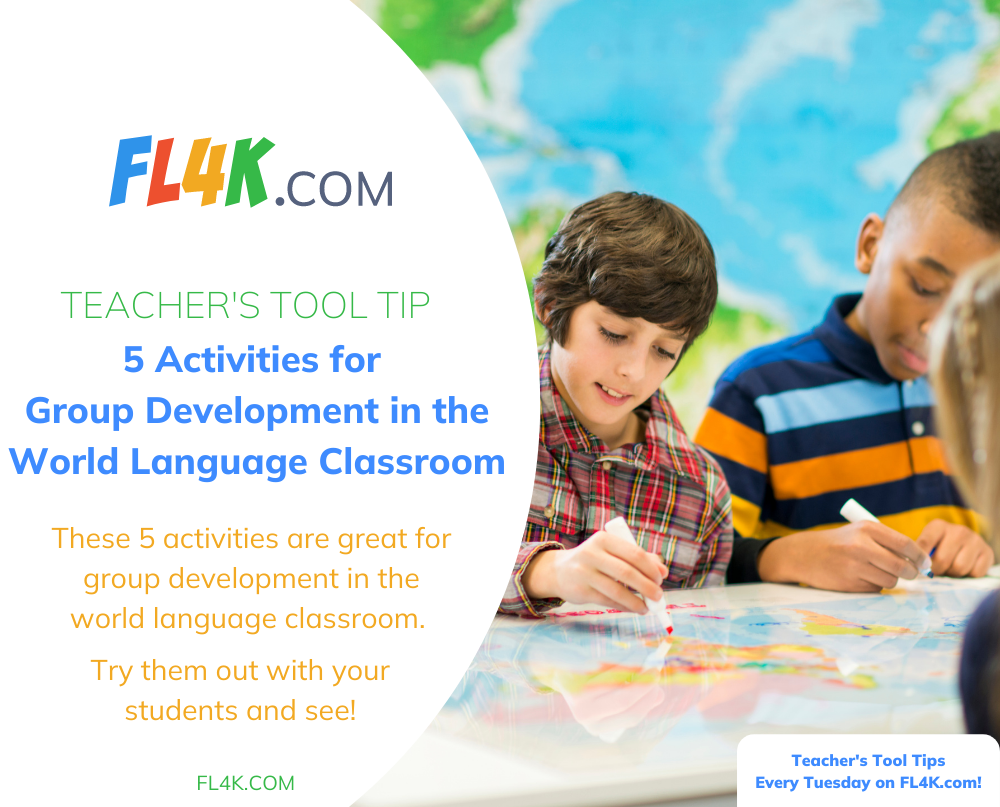If you’re looking for ways to bring your students together, these 5 activities are great for group development in the world language classroom. Try them out with your students and see!
1. FORMING, the first phase of group development
The first phase and activity for group development in a classroom is FORMING. FORMING activities are appropriate at the beginning of the year or the beginning of every class period in the World Language Classroom. Students need to get to know each other in order to reduce intimidation and encourage their participation. If you don’t do these activities already, consider adding them to your lesson plans to help build community in your classroom.
2. THIS or THAT
You can do something as simple as making a PowerPoint daily of THIS or THAT! Have kids line up according to whether they like the Chicago Bears or the Green Bay Packers (the rivalry in my area). Then they have to explain to someone next to them why they like (“me gusta…”) one better than the other.
You can keep it as simple as red or blue, beach or mountains, chocolate or vanilla, or make it relevant to a set of vocabulary or cultural themes you are studying.
With the current online Spanish program company I am working for, FL4K, there is a cultural component that is very rich for this particular activity.
The program includes short cultural segments related to eight different Spanish-speaking countries that include the following categories: nature, adventure, lodging, global issues, art, music, food, products, citizens, transportation, site of interest, regional Spanish expressions, etc.
Students have a chance to learn about all these categories in Instagram-like posts. They are available with a single platform, including interactive real-time polling, discussion questions, and recording features perfect for the digital generation.
Students can learn at their own pace due to the wide range of language levels available for each student, from Novice to Intermediate and Heritage levels. With this platform, students can even vote digitally on what they are most interested in and then practice sharing the reasons why with their classmates in the target language. This is a perfect way for students to get to know each other. Learning new cultural information in the target language and sharing opinions about it is a very motivating and engaging way to teach language.
This platform is available as a toolkit if you are not interested in using the entire program. Check it out at FL4K.com.
3. Bucket List
As students learn about other cultures in depth, have them Think-Pair-Share what would be their preferred things to do in the country that they are studying (Bucket List).
Students could learn to explain the Why (¿Por qué?) of their choices as they move from Novice to Intermediate in their language development. They could also begin to ask questions to each other about their choices.
What happens with a rich cultural program is that students are not learning language in a vacuum. They are enriching their cultural knowledge as they build language proficiency.
FL4K has carefully scaffolded the language elements so that familiar chunks of language are repeated over and over until they are adopted naturally. For teachers with IB and AP programs in their departments, this is a perfect way to build cultural knowledge while building language proficiency. Take a look at our website at FL4K.com. You will be amazed by the striking images and fascinating cultural topics presented in a very appealing way for Gen Z! NO more boring textbooks and irrelevant cultural topics.
4. Four Corners
Every unit in the FL4K curriculum introduces basic vocabulary, verb structures, and dynamic cultural material that includes global challenges.
Four Corners is an activity for group development that allows students to group according to their own interests or opinions. The only thing you have to do is present the ideas.
With FL4K, we give you the controversial ideas in our global challenge segment of each cultural unit. You could have the students go to the corners according to which Global Challenge interests them most: Saving turtles, Recycling, Deforestation/Reforestation, Protecting endangered species, etc. Again, this gives students a chance to express their own opinions as they learn about becoming responsible global citizens.
5. Nostalgia
Have students talk about things they used to do before they learned about global challenges (imperfect verb tense), and what they are doing differently now. They can also just share their interests as children and maybe some of their more global interests now that they are learning about different parts of the world!
There truly are so many ways to encourage group development, global citizenship, and language proficiency all at the same time!
Take a look at FL4K.com today and sign up for our free trial to see how our curriculum and/or toolkit has infinite possibilities for enhancing your language program!
I’ll be back next week with another tooltip but in the meantime, be sure to read any past tips that you may have missed. See you next week!
